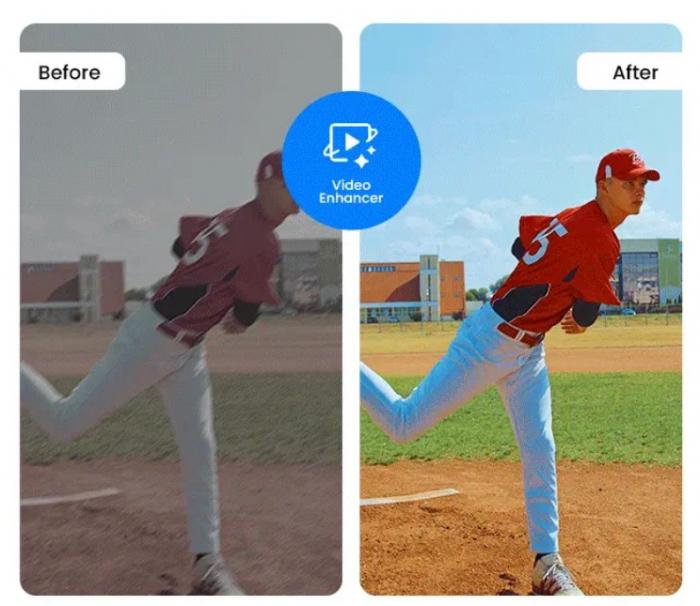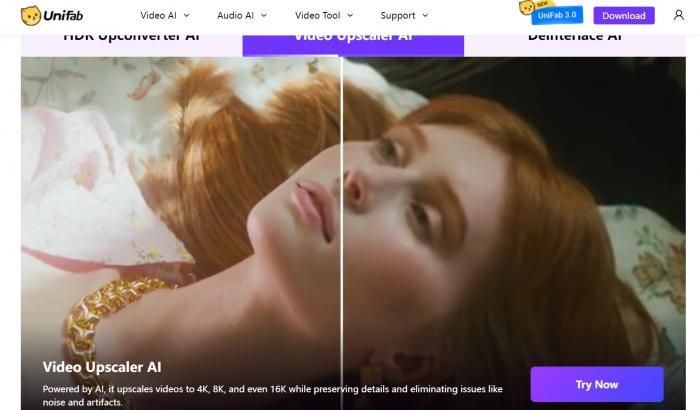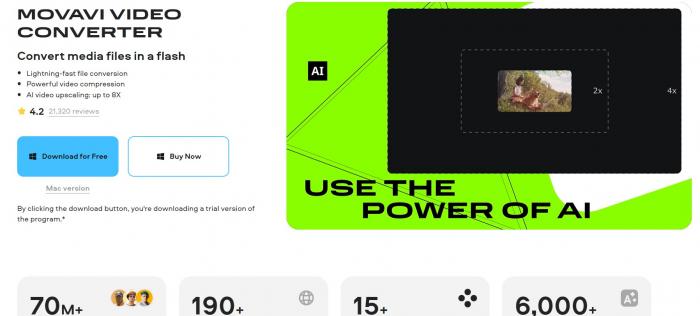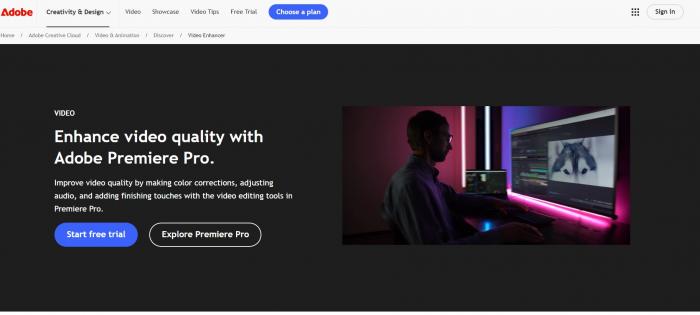
Table of Contents
- 1. For Quickly Complete Tasks Online Without Downloading - Media.io Video Enhancer
- 2. For Complete Operations on Mobile Devices - PowerDirector
- 3. For Beginners Who Want a Simple Yet Powerful Solution - UniFab
- 4. For Users Who Seeking Lightning-Speed Performance - Movavi
- 5. For Professionals Who Strive for Perfection - Adobe
The Video Upscaler Powered By AI
What?
What is video upscaler?
A video upscaler is like a "remastering tool" for old or blurry videos. Imagine digging up a family video from the past—it’s probably fuzzy, pixelated, or just low quality by today’s standards. A video upscaler fixes that. Instead of just stretching the image (which makes it look worse), it uses smart algorithms—often powered by AI—to guess missing details. For example, it might sharpen edges, smooth out blocky areas, or even fill in colors that got washed out over time. In other words, this tool doesn’t create details out of nothing. Instead, when you feed it a video, it uses AI to analyze and simulate missing elements—sharpening textures, filling gaps, and boosting overall quality. By using AI algorithms, it breathes new clarity into blurry memories captured on video, turning faded moments into vivid snapshots of the past. This is something you can never believe in the past.

Why?
Why Do You Need It?
You're probably dying to know:what's the magic behind this game-changing tool? Let me paint you a picture: Those wobbly vacation videos that look like they were shot during an earthquake? The dimly lit concert clips where your favorite artist resembles a shadow puppet? Those "supposed-to-be-epic" moments ruined by focus issues making everything look like abstract art? Sounds like a disaster, but don't worry!Here is video upscaler!
This isn't just another filter app - it's like having a Hollywood post-production team in your pocket. That shaky handheld footage now seems like shot on a professional gimbal rig. Dark scenes brighten to reveal details you didn't know you captured. Blurry messes sharpen into crystal-clear moments worthy of a director's cut. Best part? You don't need Spielberg-level skills, it transforms shaky smartphone footage into studio-quality content before your coffee gets cold. Just one click!
Imagine finally unwinding after a brutal workday—you settle in to stream a free movie, only to discover it looks like a 1990s security camera recording. Blurry faces, jagged edges, and pixels dancing like static confetti completely kill the vibe. This is where the tool truly shines. That grainy, low-resolution copy of your favorite classic film? The video upscaler revitalizes every frame, restoring details so clearly you might notice subtle background movements you never saw before. Suddenly, your screen delivers smooth, theater-quality visuals—so sharp and fluid, you’ll feel like you’re watching a remastered Blu-ray edition.
Here’s the best part: Whether you’re restoring old family videos or rewatching nostalgic TV shows, this tool doesn’t just improve quality—it transforms experiences. Shaky phone footage becomes Hollywood-worthy. Blurry movie files get upgraded to stunning 4K clarity. The question isn’t if you need it—it’s what will you enhance first?

How?
How Does It Work?
As we've covered, the AI-powered upscaler handles all the complex enhancement and restoration work behind the scenes—no technical expertise required. Simply upload your video, describe your vision, and watch as it transforms into a polished masterpiece automatically. Transform grainy 1990s black-and-white footage into vivid, full-color HD masterpieces – our AI breathes life into historical clips while sharpening details to modern cinematic standards. For professionals? We've built in granular controls to fine-tune every parameter. Whether you're a casual creator or a post-production wizard, this tool bridges the gap between 'good enough' and 'flawless' in your pursuit of visual perfection.

Evolution and Technical Progression of Video Upscaler
Video upscaler has undergone significant transformations, driven by advancements in computational power, algorithmic innovation, and artificial intelligence. Now let's talk about its development history and key milestones.
1. Early Phase: Basic Interpolation Algorithms (1980s–Early 2000s)
Well, actually the term 'video upscaler' wasn't officially coined until 2015, though similar concepts had already existed prior to that. And we just call it video upscaler for convenience in understanding.
Initial video upscaler relied on simple mathematical methods like bilinear and bicubic interpolation, which increased pixel count but failed to generate new details. These techniques often resulted in blurry or distorted outputs, especially for low-resolution videos (e.g. 480p).
During the CRT television era, the first attempts to upscale low-resolution videos relied on bilinear interpolation (proposed 1981) and bicubic interpolation (refined 1987). These methods filled new pixels by copying neighbors, similar to enlarging a pixel art image—resulting in blocky, indistinct visuals.
|
Engineers improved techniques by: Developing advanced edge detection (e.g. 1998 optimized Sobel operator). Introducing hardware accelerators (ATI Rage 128) enabling real-time previews. And creating professional software like Discreet Cleaner (2000) combining scaling and noise reduction.
|
Limitations: Hardware constraints and limited processing power restricted real-time applications, making these methods suitable only for basic tasks like broadcast signal conversion. |
2. Intermediate Phase: Motion Compensation and Codec Integration (2000s–2010s)
The 2000s–2010s witnessed a pivotal shift in video upscaler, driven by the rise of HD and early 4K displays. As consumers embraced flat-screen TVs and Blu-ray players (launched in 2006), expectations soared for sharper visuals, yet much legacy content—DVDs, broadcast TV, and early web videos—remained stuck in lower resolutions. This mismatch sparked innovations to bridge the gap. Advanced codecs like H.264 (2003) and H.265/HEVC (2013) introduced motion compensation, allowing upscalers to analyze movement between frames, reducing blurring and "ghosting" in fast-paced scenes. Devices like Blu-ray players and AV receivers began offering real-time 1080p-to-4K conversion by the early 2010s, though results often prioritized smoothness over authentic detail, leaving textures looking artificially soft.
Video upscaler tools like Adobe Premiere Pro (adding basic upscaling in CS6, 2012) enabled creators to enhance old footage, but processing was slow and required manual tweaking. Meanwhile, the growth of streaming services like Netflix (which debuted 4K in 2014) pressured studios to upscale archives, revealing the limits of these methods: while motion handling improved, fine details—hair, fabric textures, distant objects—still lacked precision. Yet this era laid critical groundwork, proving that intelligent algorithms, not brute-force pixel stretching, were key to video upscaler’s future. It set the stage for AI-driven breakthroughs, transforming upscaling from a niche technical fix into a cultural necessity in the HD-to-4K transition.
|
Limitations: low details and slow speeds. |
3. Modern Era: AI-Driven Super-Resolution (Late 2010s–Present)
The integration of deep learning revolutionized video upscaler, using AI to improve quality.
The late 2010s to today have turned video upscaling into a smart software revolution, fueled by the rise of deep learning. As streaming platforms like Netflix and YouTube pushed 4K/8K content, viewers craved cinematic quality not just for new releases but also for grainy classics or shaky smartphone clips. Enter AI-driven tools: Generative Adversarial Networks (GANs) became game-changers, trained on millions of high/low-resolution video pairs. Unlike older methods that guessed missing details, GANs learn to reconstruct textures—think converting a blurry 480p DVD scene into sharp 4K by realistically adding skin pores, fabric weaves, or even raindrops that never existed in the original.
Modern video upscaler like UniFab or Adobe’s updated tools now bundle upscaling with fixes for noise, motion blur, and unstable frames—essentially a 'digital time machine' for restoring old films or fixing shaky concert footage. Meanwhile, GPUs like NVIDIA’s RTX series enabled real-time 8K upscaling, letting gamers and creators boost resolution without lag. Yet the biggest leap? Democratization. Challenges remain—overly 'AI-smoothed' faces or artificial textures still pop up—but today’s tech doesn’t just upscale pixels; it reimagines what’s possible, turning yesterday’s limitations into tomorrow’s canvas.
- Generative Adversarial Networks (GANs): Trained on high/low-resolution video pairs, GANs predict and reconstruct missing details (e.g. converting 480p to 4K).
- Multi-Task Processing: Modern tools like Adobe combine upscaling with noise reduction, deblurring, and frame-rate conversion, enabling holistic video restoration.
- Real-Time 8K Upscaling: GPU acceleration and lightweight models allow 8K processing in real time, empowering both professionals and consumers.
|
Limitations: While multiple tools exist, paid software might not always meet expectations for certain functions. Careful evaluation helps ensure your investment aligns with actual needs. |
The Selection and Recommendation of Video Upscaler.
The following content is based on the author's personal experience and other passages, So it may not be entirely objective or accurate. It is provided for readers' reference only. Wish all of you can find the special one for yourself.
1. For Quickly Complete Tasks Online Without Downloading - Media.io Video Enhancer
https://www.media.io/apps/video-enhancer/

Media.io Video Enhancer: AI-Powered Enhancement Without Downloads
Media.io Video Enhancer is a cutting-edge online tool that leverages AI to instantly upscale and refine video quality directly in your browser, eliminating the need for software downloads. Designed for simplicity, it supports 2X and 4X super-resolution scaling, transforming low-resolution or blurry videos into crisp 4K output with minimal effort. Users simply upload videos in MP4, AVI, or MOV formats, select the desired enhancement level, and let the AI process the content within seconds.
This video upscaler excels in restoring old home videos, stabilizing shaky footage, and improving AI-generated or low-light recordings, making it ideal for filmmakers, content creators, and nostalgic users. Its intuitive interface requires no technical skills, and real-time previews allow adjustments before final export. While free users can process files up to 50MB (30 seconds), registered accounts handle larger files (100MB, 1 minute), with subscription plans unlocking unlimited capabilities.
Though limited to MP4/MOV formats and lacking batch processing, Media.io’s cloud-based efficiency, combined with AI-driven clarity and color optimization, positions it as a go-to solution for quick, high-quality video enhancement across devices.
Ideal for: Quick 4K upscaling, online blur/shake removal
|
Pros ✅Instant processing ✅Free Basic ✅Without installation |
Cons ❗Limited details ❗Low quality ❗Simple styles |
2. For Complete Operations on Mobile Devices - PowerDirector

PowerDirector: AI Video Upscaler used on Mobile!
PowerDirector delivers professional video enhancement with its AI-powered upscaler, utilizing TrueVelocity engine and hardware acceleration (NVIDIA/Intel/AMD) to smoothly upscale low-res videos to 4K with minimal quality loss. Designed for mobile users, its Android app enables 4K editing and output, transforming old footage into sharp, vibrant content.
Key features include TrueTheater Color AI, which auto-adjusts brightness and saturation for lifelike visuals, and an intuitive mobile interface for drag-and-drop editing. The app works offline, supports batch processing, and handles formats like MP4/MKV, ideal for social media creators on the go.
Compact (under 300MB) yet powerful, PowerDirector combines AI precision with mobile flexibility, turning everyday clips into cinematic quality—anytime, anywhere.
Ideal for: Video editing & enhancement on mobile
|
Pros ✅IOS & Android ✅Wide range of tools ✅Automatically |
Cons ❗Some tools are premium ❗Low quality ❗Large file size |
3. For Beginners Who Want a Simple Yet Powerful Solution - UniFab

UniFab: AI-Powered Video Upscaler for Enhanced Visual Excellence
UniFab is a versatile multimedia tool renowned for its advanced AI-driven video upscaler, designed to transform low-resolution content into high-definition masterpieces. The software integrates Video Enlarger AI and HDR Upscaler AI modules, which utilize deep learning algorithms to upscale videos up to 1080p and enhance dynamic range to HDR10 or Dolby Vision standards, delivering vivid colors, sharper details, and improved brightness. This technology ensures minimal quality loss while converting formats like 360p or 720p into crisp, theater-worthy visuals.
Expanding color gamuts and optimizing luminance for compatible devices. The AI also enhances audio quality by upmixing stereo tracks to immersive DTS 7.1 or EAC3 5.1 surround sound, ideal for cinematic experiences.
UniFab supports 1,000+ video formats, ensuring seamless compatibility across devices, from smartphones to 4K TVs. Its batch processing capability allows simultaneous upscaling of multiple files, while hardware acceleration (optimized for NVIDIA/AMD GPUs) ensures rapid processing even for large 8K/4K files.
Combining AI precision with user-friendly workflows, UniFab is a top choice for new filmmakers and enthusiasts seeking professional-grade video enhancement without compromising efficiency.
Ideal for: Beginners & good quality
|
Pros ✅Easy for use ✅High quality ✅Automatically |
Cons ❗Some tools are premium ❗Little kinds of style ❗Slow |
4. For Users Who Seeking Lightning-Speed Performance - Movavi
https://www.movavi.com/movavi-video-converter.html?

Movavi Video Converter: Speed and Versatility Redefined
Movavi Video Converter combines cutting-edge technology with user-friendly design to deliver unmatched performance. Its standout feature, SuperSpeed mode, accelerates conversions by up to 79x without quality loss, ideal for handling 4K/8K videos. Leveraging hardware acceleration (NVIDIA, Intel, AMD), it maximizes GPU and CPU efficiency, ensuring rapid processing even for large files.
This video upscaler use an AI enhancement feature automatically improves video clarity and audio quality, while its smart device recognition suggests optimal formats for over 200 devices.
Users enjoy batch processing and a "Watch Folder" automation feature, alongside basic editing tools for trimming, merging, and adding effects. The dual-pass encoding balances file size and output quality, and it even extracts audio or creates GIFs effortlessly.
With an intuitive interface and cross-platform support (Windows/macOS), Movavi Video Converter is perfect for both casual users and pros seeking fast, reliable multimedia solutions.
Ideal for: Fast & still fast
|
Pros ✅Faster ✅Versatile ✅User-friendly |
Cons ❗Some tools are premium ❗Limited details ❗Device-dependent |
5. For Professionals Who Strive for Perfection - Adobe
https://www.adobe.com/creativecloud/video/discover/video-enhancer.html

Adobe Premiere Pro: King of the video upscaler
As one of the earliest pioneers in the video upscaler, Adobe needs no introduction. Its reputation is built on perfection and unparalleled professionalism, which speak for it. Equipped with the highest technology, Adobe delivers an unmatched experience—though its pricing and learning curve are equally top-1(LOL). For those outside of professional video production or corporate environments, Adobe might feel like overkill—akin her by using a cannon to swat a fly.
Ideal for: Professionals & Top 1 for quality
|
Pros ✅Perfect ✅Meet everything you want ✅Wide range of styles |
Cons ❗Expensive ❗Too difficult ❗Hard to use |
Conclusion
With the continuous advancement of technology, we believe video upscaler will continue to improve. We also hope that after reading this article, readers will gain a more comprehensive understanding of video upscaler and try using this technology to derive practical benefits in their daily lives. For specific comparisons and more detailed information, we invite you to read our follow-up articles.
There are other interesting posts for you to read:
KeepVid: Download YouTube Videos Free with Secure Tool
How to Download Amazon Prime Videos: Amazon Video Downloader Recommended
MKV vs MP4: 2025 Ultimate Guide to Choosing the Best Video Format
Table of Contents
- 1. For Quickly Complete Tasks Online Without Downloading - Media.io Video Enhancer
- 2. For Complete Operations on Mobile Devices - PowerDirector
- 3. For Beginners Who Want a Simple Yet Powerful Solution - UniFab
- 4. For Users Who Seeking Lightning-Speed Performance - Movavi
- 5. For Professionals Who Strive for Perfection - Adobe
